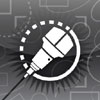Cut (keyboard shortcut ⌘X) deletes the selected object and puts it on the clipboard, from where it can be pasted.
Copy (keyboard shortcut ⌘C) copies the selected object and puts it on the clipboard, from where it can be pasted.
Paste (keyboard shortcut ⌘V) pastes either the last deleted or the last copied object from the clipboard. An object pastes on to the active layer, regardless of which layer it is copied or deleted from – which is a useful method of moving objects from one layer to another – for example if you have inadvertently drawn an object on the wrong layer.
 Paste special... (keyboard shortcut ⌥⌘V) allows you to specify where you want to paste the object, through the pane shown on the right.
Paste special... (keyboard shortcut ⌥⌘V) allows you to specify where you want to paste the object, through the pane shown on the right.
At mouse. Checking this box allows you to paste the object where you click the mouse.
On the drawing. Checking this box allows you to paste the object relative to the drawing, controlled by the location selected by Anchoring (see below).
If both boxes are unchecked, the object will paste on top of itself.
Anchoring is only active if either the "At mouse" or "On the drawing" box is checked. With "At mouse" selected, anchoring defines which point on the object is pasted at the mouse click position. This can be very useful in conjunction with "Snap". So, for example. if you were pasting a circle, you could select to paste it by its center, hit the OK button, and move the mouse to snap to the end point of a line and click the mouse. The circle would paste with its center on the end point of the line. With "On the drawing" selected, Anchoring selects the location on the drawing where the object will be pasted.
Tip:If you are pasting several objects you need to group them first if you want them to retain their positions relative to each other. For example if you want to paste a page border and a left hand corner title box so that the border sits centrally on the page and the title box stays at the left hand corner - group them first.
Through layers. As mentioned above, by default, an object pastes on to the active layer, regardless of which layer it is copied from. Checking the "Through layers" box pastes the object on to the layer it came from, even if that layer is not the active layer. This applies if you are pasting from layer in the same drawing, or on to a different layer (provided that layer exists on the receiving drawing)
Create missing layers. Can only be checked if the "Through layers" box is checked. An object on the clipboard retains its layer information, even if that layer has subsequently been deleted. If that be the case, checking this box will re-create the deleted layer and paste the object on to it. And, if pasting to a different drawing, it will create the layer to paste it to.
 Pasting and Scale. There's no special menu item for this function. But if you copy an object from one drawing or layer and paste it on to a drawing or layer that is at a different scale, RealCADD will ask you if you want to re-scale the object from its original scale to the scale of the receiving drawing (or layer).
Pasting and Scale. There's no special menu item for this function. But if you copy an object from one drawing or layer and paste it on to a drawing or layer that is at a different scale, RealCADD will ask you if you want to re-scale the object from its original scale to the scale of the receiving drawing (or layer).
In this example:
Yes will scale the object up from 1/20 to 1/10 (so it will be double its original size), and paste it at 1/10 scale. So say the object is a circle of 100mm diameter. It will double in physical size but still read as 100mm diameter at 1/10 scale
No will keep the object at its original physical size, but paste it at 1/10 scale. So our 100mm circle will now read as 50mm diameter at 1/10 scale.
Clear deletes the selected object but does not put it on the clipboard. The deleted object cannot subsequently be pasted.
